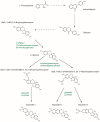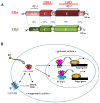An Update on the Effects of Glyceollins on Human Health: Possible Anticancer Effects and Underlying Mechanisms
- PMID: 30609801
- PMCID: PMC6357109
- DOI: 10.3390/nu11010079
An Update on the Effects of Glyceollins on Human Health: Possible Anticancer Effects and Underlying Mechanisms
Abstract
Biologically active plant-based compounds, commonly referred to as phytochemicals, can influence the expression and function of various receptors and transcription factors or signaling pathways that play vital roles in cellular functions and are then involved in human health and diseases. Thus, phytochemicals may have a great potential to prevent and treat chronic diseases. Glyceollins, a group of phytoalexins that are isolated from soybeans, have attracted attention because they exert numerous effects on human functions and diseases, notably anticancer effects. In this review, we have presented an update on the effects of glyceollins in relation to their potential beneficial roles in human health. Despite a growing number of studies suggesting that this new family of phytochemicals can be involved in critical cellular pathways, such as estrogen receptor, protein kinase, and lipid kinase signaling pathways, future investigations will be needed to better understand their molecular mechanisms and their specific significance in biomedical applications.
Keywords: breast cancer; dietary compounds; estrogen receptor; glyceollins; human health; phytochemicals; signaling pathways.
Conflict of interest statement
The authors declare no conflict of interest.
Figures





Similar articles
-
Glyceollins, a novel class of soy phytoalexins, inhibit angiogenesis by blocking the VEGF and bFGF signaling pathways.Mol Nutr Food Res. 2013 Feb;57(2):225-34. doi: 10.1002/mnfr.201200489. Epub 2012 Dec 10. Mol Nutr Food Res. 2013. PMID: 23229497
-
Soyabean glyceollins: biological effects and relevance to human health.Proc Nutr Soc. 2012 Feb;71(1):166-74. doi: 10.1017/S0029665111003272. Epub 2011 Nov 7. Proc Nutr Soc. 2012. PMID: 22054259 Review.
-
Glyceollins, a novel class of soybean phytoalexins, inhibit SCF-induced melanogenesis through attenuation of SCF/c-kit downstream signaling pathways.Exp Mol Med. 2013 Apr 5;45(4):e17. doi: 10.1038/emm.2013.20. Exp Mol Med. 2013. PMID: 23559126 Free PMC article.
-
Total Synthesis of (±)-Glyceollin II and a Dihydro Derivative.J Nat Prod. 2015 Dec 24;78(12):2940-7. doi: 10.1021/acs.jnatprod.5b00607. Epub 2015 Dec 11. J Nat Prod. 2015. PMID: 26654660
-
Glyceollin, a soybean phytoalexin with medicinal properties.Appl Microbiol Biotechnol. 2011 Apr;90(1):59-68. doi: 10.1007/s00253-011-3169-7. Epub 2011 Feb 20. Appl Microbiol Biotechnol. 2011. PMID: 21336922 Review.
Cited by
-
Dietary Bioactive Compounds and Breast Cancer.Int J Mol Sci. 2023 Jun 4;24(11):9731. doi: 10.3390/ijms24119731. Int J Mol Sci. 2023. PMID: 37298682 Free PMC article.
-
Management of triple-negative breast cancer by natural compounds through different mechanistic pathways.Front Genet. 2024 Jul 26;15:1440430. doi: 10.3389/fgene.2024.1440430. eCollection 2024. Front Genet. 2024. PMID: 39130753 Free PMC article. Review.
-
Glyceollin Transcription Factor GmMYB29A2 Regulates Soybean Resistance to Phytophthora sojae.Plant Physiol. 2020 Jun;183(2):530-546. doi: 10.1104/pp.19.01293. Epub 2020 Mar 24. Plant Physiol. 2020. PMID: 32209590 Free PMC article.
-
The VHL/HIF Axis in the Development and Treatment of Pheochromocytoma/Paraganglioma.Front Endocrinol (Lausanne). 2020 Nov 24;11:586857. doi: 10.3389/fendo.2020.586857. eCollection 2020. Front Endocrinol (Lausanne). 2020. PMID: 33329393 Free PMC article. Review.
-
Glyceollin biosynthesis in a plant chassis engineered for isoflavone production.Nat Chem Biol. 2025 May 28. doi: 10.1038/s41589-025-01914-3. Online ahead of print. Nat Chem Biol. 2025. PMID: 40437134
References
-
- Knaze V., Rothwell J.A., Zamora-Ros R., Moskal A., Kyrø C., Jakszyn P., Skeie G., Weiderpass E., Santucci de Magistris M., Agnoli C., et al. A new food-composition database for 437 polyphenols in 19,899 raw and prepared foods used to estimate polyphenol intakes in adults from 10 European countries. Am. J. Clin. Nutr. 2018;108:517–524. doi: 10.1093/ajcn/nqy098. - DOI - PubMed
Publication types
MeSH terms
Substances
LinkOut - more resources
Full Text Sources

